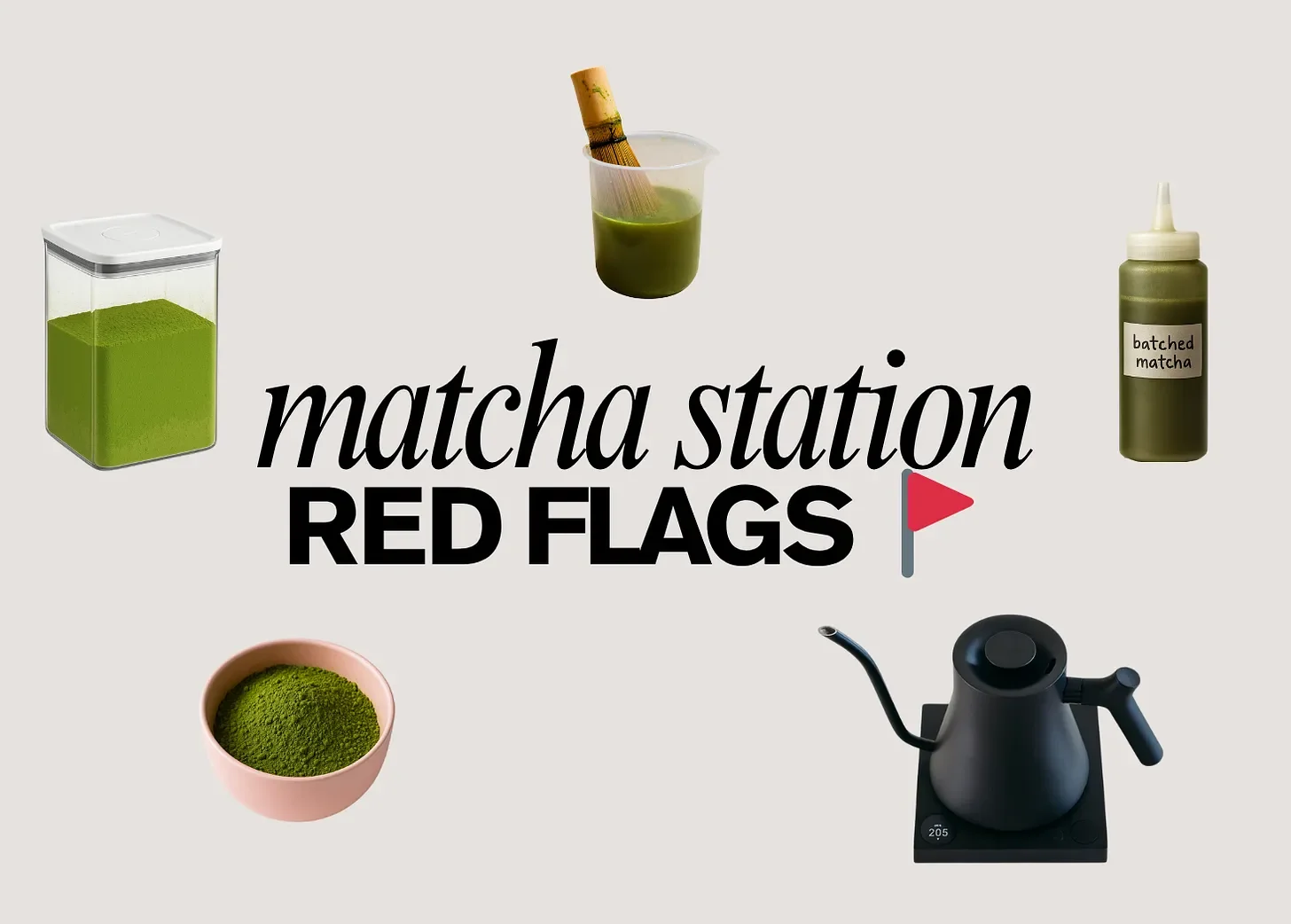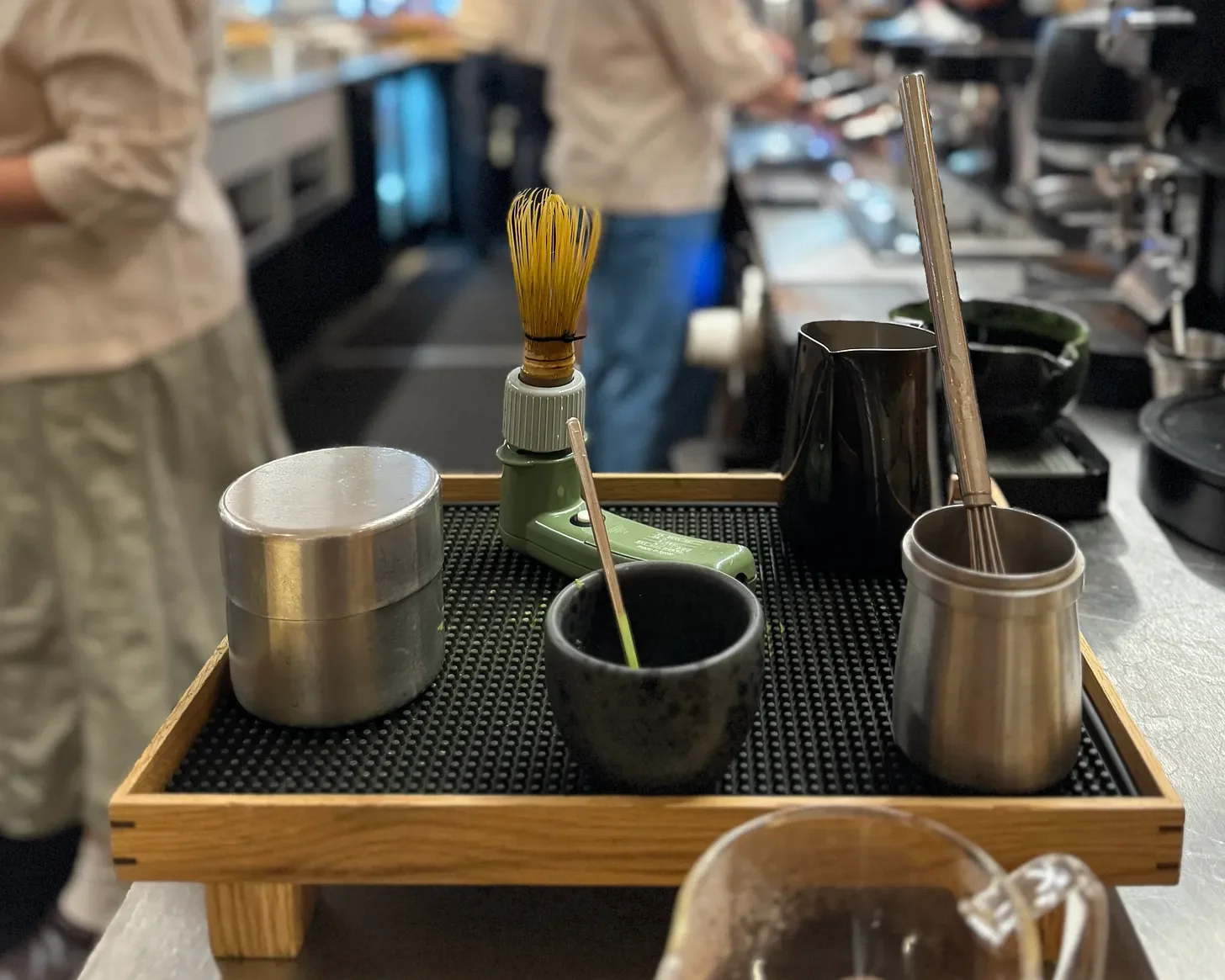Matcha Station Design: What Your Setup Says About Your Program
TL;DR for Busy Operators
Your matcha station is your program’s first impression to customers.
A cluttered, oxidized, or unhygienic setup signals disorganization and lack of care, even if your team is using premium matcha.
A clean, intentional, and well-maintained station signals knowledge, consistency, and respect for the craft.
Small changes (airtight storage, temperature control, clean tools) dramatically improve flavor, color, and customer experience.
The Bigger Picture
The bar for great matcha experiences in cafes that manage both coffee and matcha programs is still low. Customers often express disappointment in their matcha—not because they don’t love it, but because the execution misses the mark.
During our travels, we’ve seen a common thread: a lack of matcha education designed specifically for foodservice. While there’s endless information written for consumers, few resources address the operational realities of high-volume cafes.
The good news: you’re here. You subscribe to The Matcha Program, and that already shows the level of care and dedication you bring to your business and customer experience. Our goal is to resource you with practical matcha knowledge so you can deliver consistently great matcha every single time.
The Business Case for a Well-Designed Matcha Station
Matcha station at popular NYC specialty cafe La Cabra. Green flags include: dedicated area for matcha prep, dark and airtight matcha storage, clean prep area.
A thoughtfully designed matcha station isn’t just about aesthetics—it’s about efficiency, consistency, and profitability.
Here’s why it matters:
Faster service: When tools and ingredients are arranged logically, baristas move efficiently and make fewer mistakes.
Less waste: Airtight storage and proper batching extend shelf life and reduce oxidation-related product loss.
Higher perceived value: Customers associate visible care and cleanliness with premium pricing. A $7 matcha latte feels justified when the setup looks professional.
Staff retention: When systems are clean and consistent, training becomes easier and baristas take more pride in their workspace and in the overall matcha program.
Your station is a small area that can make a major impact on both workflow and brand perception.
Optics Matter: What Your Matcha Station Communicates
In an era where everything is photographed, filmed, and shared, your matcha station design says a lot.
If visible, it’s often one of the first signals of your program’s intentionality (or lack of it). A thoughtfully designed matcha station builds trust, especially among today’s increasingly discerning matcha drinkers who notice everything—from water temperature to powder color.
What Is a Matcha Station?
A matcha station is the dedicated area of your countertop for matcha preparation and equipment—your mini tea lab.
In most cafes, this is a small section or corner shared with coffee prep. Typically, we see:
Large clear containers filled with matcha powder
Stained bowls and whisks left soaking in murky water
Spilled powder on counters
Bottles of batched matcha sitting on countertops in light or warm environments
These setups unintentionally communicate that matcha is secondary to coffee, and customers feel that.
Matcha Station Layout 101
Think of your station like a mise en place for tea. Every inch should serve a purpose.
Key Zones to Consider:
Prep Zone: Scale, sieve, whisk, and water source. Keep microfiber towels nearby.
Storage Zone: Airtight, dark containers that block light, labeled by grade or blend.
Service Zone: For batching or assembling drinks.
Tips for Tight Spaces or Pop-Up Models:
Use stackable or magnetic containers to maximize vertical storage.
Consider mobile carts or mini fridges for batching near service areas.
Keep separate cloths for matcha and coffee cleanup to avoid residue or aroma transfer.
Red Flags to Green Flags
A quick checklist to elevate your matcha station
Cold Drink Optimization
If 80% of your matcha drinks are iced (which is common), your station should be optimized for cold preparation, not just traditional hot whisking.
Tips for Cold Workflows:
Store batched matcha in an ice bath or mini fridge near your drink assembly area.
Use narrow-mouth bottles for easy pouring and reduced oxidation exposure.
Prep batched matcha with filtered, cold (or hybrid temperature) water to preserve color and minimize separation.
Always shake before use, as matcha will naturally settle at the base of a bottle if left idle.
Discard any leftover batch after 24 hours.
The small detail of keeping matcha cold and stable can make or break flavor quality and matcha color in iced beverages.
Training and Team Rituals
Even the best-designed station won’t stay consistent without team alignment. Build habits that keep your program strong.
Ideas to Implement:
Daily Open/Close Checklist: Include wiping surfaces, soaking bamboo tines in hot water before service, checking water temperature tools, and replacing old towels.
Weekly Deep Clean: Fully empty, sanitize, and restock containers.
Pre-Service Ritual: Spend 10 minutes prepping matcha station, testing water temperature, and checking whisk condition.
Staff Education: Train every team member to explain matcha’s basics in 30 seconds—origin, type, and flavor notes.
Team ritual builds pride, and customers notice when baristas care about the details.
Social Media Optics: The Matcha Station as a Marketing Asset
Your matcha station can double as a storytelling backdrop. Social media thrives on behind-the-scenes visuals that signal craft, care, and authenticity.
Quick Wins:
Keep surfaces clean and visually consistent with your brand’s aesthetic.
Use branded towels, ceramics, or bottles for cohesion.
Capture natural light and overhead shots when whisking.
Share the “why” behind your setup and preparation method; transparency builds trust.
Tools and Equipment Recommendations
Operators often ask, “What tools make the biggest difference?”
Here are some we’ve tested or seen work well across high-volume cafes:
Temperature control: Bonavita or Fellow Stagg EKG kettles
Storage: Small to medium airtight and dark containers, amber glass jars, Mylar pouches with zip seals
Whisk options: Traditional bamboo, or silicone/resin for high-volume use
Measurement: 0.1g precision digital scales
Batching tools: Funnels, pitchers, and countertop ice baths for prep. See our full Substack on batching matcha for more tips.
These small investments create operational consistency and show guests that you take the same precision with matcha as you do with coffee.
Material Alternatives for High-Volume Cafes
If hand-whisking is integral to your brand experience but maintaining bamboo whisks is unsustainable, try silicone or resin whisks.
They’re durable, food-safe, and dishwasher-friendly—ideal for volume environments. While they may produce slightly less fine foam, it’s a worthwhile trade-off for cleanliness and consistency, especially if you primarily serve iced matcha lattes where crema isn’t as noticeable. We’ll dive deeper into this topic in a future post.
Future-Proofing Your Matcha Program
As matcha continues to grow in popularity, expectations for professionalism and transparency will rise alongside it.
In the same way coffee evolved from “drip” to “specialty,” the next wave of matcha will be defined by education, consistency, and care.
An intentionally designed station—with clear systems, clean tools, and thoughtful presentation—is your foundation for scaling a sustainable matcha program that stands out and stays ahead.
Final Thoughts
Your matcha station is your silent spokesperson. It tells your customers and your team how seriously you take your craft. With small, intentional changes, you can dramatically elevate both workflow and guest perception. Remember: great matcha isn’t just about the powder itself; it’s about how it’s handled, stored, and served.





